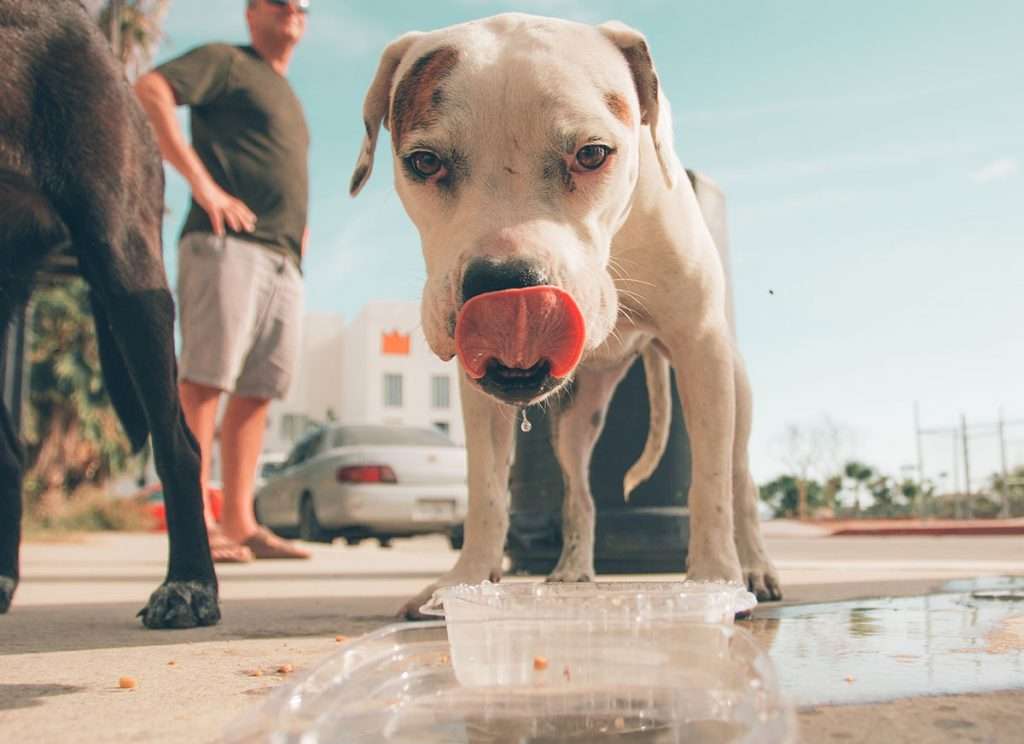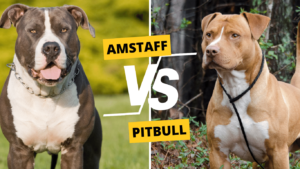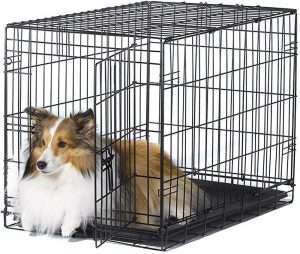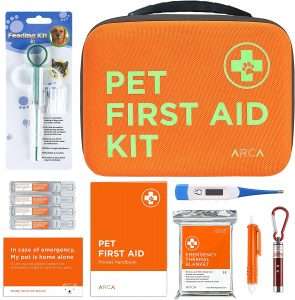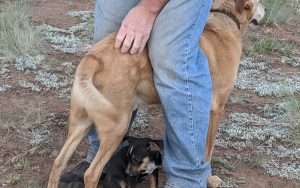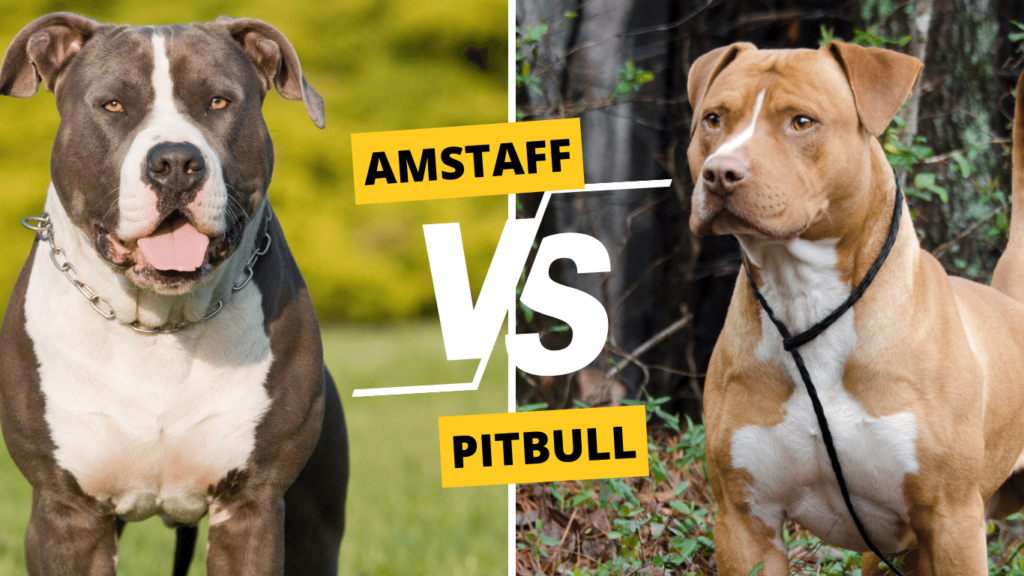
Dog Stung by Bee on Paw: Symptoms, Treatment & Prevention Guide
-
 By
Victoria Bennett
By
Victoria Bennett
- Last updated: September 9, 2023
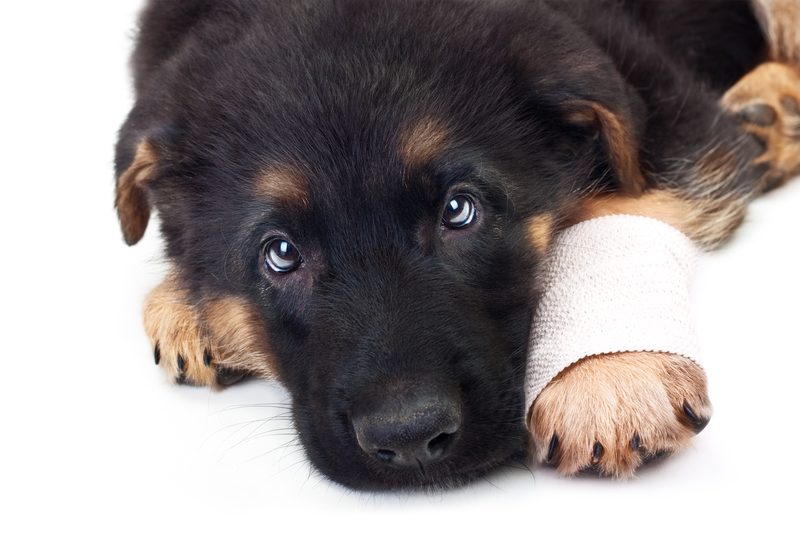
Playful by nature, dogs often put their noses and paws where they don’t belong, resulting in a sting from an unsuspecting bee. While some stings are merely annoying, others can be quite painful.
Most of the time, a bee sting will cause only local swelling and redness. However, if you’ve noticed that your dog has been limping, it’s possible that the sting has caused an allergic reaction or even other more serious problems.
No pet owner wants their doggie to go through this experience, but unfortunately, it does happen from time to time. Understanding what to do if it happens to your pup can help make the process go a bit more smoothly – and help your dog feel better faster.
Table of Contents
Identifying A Bee Sting
Bee sting in the paw area manifests differently than a sting elsewhere on the body. If your dog has been stung on the paw, you’ll likely see one or more of the following symptoms:
- Swelling in the footpad
- Swelling in the tissue between the toes
- Hives or red welts on the skin
- Limping
- Pain when pressure is applied to the foot
- Redness and warmth in the affected area
If your dog displays any of these symptoms, it’s important to take action immediately.

First Aid For A Dog Stung By A Bee
If you think your dog has been stung by a bee, the first thing you should do is check the affected area for a stinger. A stinger looks like a small, black speck and is usually easy to spot. This could be one of the causes why your dog starts to limp and is also a good indicator of just how serious the sting might be.
Check the paws and in-between the toes for stings, as this is a common area for dogs to get stung.
Once you’ve located the stinger, gently remove it with a pair of tweezers. If you can’t see a stinger, don’t worry – it’s possible that your dog was only partially stung or that the stinger came out on its own. Sometimes, the stinger can sometimes be buried beneath the skin. A little digging might be necessary to find it.
After you’ve removed the stinger (if present), the next step is to clean the wound. Use cool water and mild soap to gently cleanse the area, being careful not to irritate it further. If you have some topical antibiotic ointment on hand, you can apply that as well. With a cotton pad, apply pressure to the wound if bleeding occurs.
Once the area is clean, you can apply a cold compress to help reduce swelling. This can be done by wrapping ice in a thin towel and holding it against the affected area for about 20 minutes. Repeat this process every few hours as needed.
For minor swelling and redness, you may also hold a cold compress on the affected area for about 15-20 minutes. Wrap the ice in a thin towel to avoid frostbite, and never apply ice directly to the skin. This will help reduce both pain and inflammation. Additionally, you can give your dog a small dose of antihistamine to help with swelling.
Assess the wound and your dog’s symptoms periodically to see if the cold compress is still necessary. Observe your dog for limping and other symptoms, and if they persist or worsen, contact your veterinarian immediately.

Treating More Serious Reactions
While most bee stings will cause only minor swelling and pain, some dogs may have a more severe reaction. If your dog is having trouble breathing, develops hives or welts over their body, or begins vomiting or having diarrhea, these are all signs of a more serious reaction, and you should take them to the vet immediately.
These severe reactions are usually caused by an allergy to the bee’s venom and require treatment with epinephrine (also known as adrenaline). This medication can help to reduce swelling and open up the airways, making it easier for your dog to breathe. In some cases, your vet may also recommend giving your dog a corticosteroid to help reduce inflammation.
Additional treatment for more serious reactions may also include fluids and oxygen therapy, depending on the severity of the reaction.
When to see the vet
If you’re unsure whether or not your dog’s reaction is serious, err on the side of caution and make an appointment with your veterinarian. Anaphylactic shock is one of the most serious reactions to a bee sting, and it can happen quickly. If not treated immediately, anaphylactic shock can be fatal.
Even if your dog’s reaction doesn’t appear to be serious, perform the first aid steps outlined above, and then call your vet for further instructions.
If you feel that it’s probably not serious enough to warrant a trip to the vet but you still want peace of mind, you can always seek out help and advice online from a licensed vet from the comfort of your own home.

Things To Avoid After A Bee Sting
Your dog’s paws are sensitive, and a bee sting can cause quite a bit of discomfort. As mentioned earlier, limping is one of the most common signs that your dog has been stung. The limp may be temporary and would go away on its own once the swelling has subsided. Usually, your dog will start walking normally within 24 hours – or at least, they’ll be able to put weight on the paw without too much discomfort.
However, there are some things you should avoid doing, as they could further irritate the affected area and make your dog’s limp worse. These include:
Using Products Containing Alcohol
Bee stings are already painful, and using products that contain alcohol will only make the pain worse. Alcohol-based products will also dry out your dog’s skin, which can lead to irritation and itchiness.
Rubbing or Scratching the Affected Area
It might be tempting to give your dog a good scratch after they’ve been stung, but resist the urge! This will only make the pain worse and could cause additional swelling. Additionally, this could also cause infection if your dog’s nails are long or dirty.
If your dog is scratching at the affected area, try to distract them with a toy or treat. You may also need to put an Elizabethan collar on them to prevent them from reaching the area.
Never Go for Long Walks
Putting pressure or forcing your dog to “walk it off” will only make the pain worse and could cause additional swelling. If your dog is limping, it’s best to let them rest until the swelling goes down.
Once the swelling has gone down, you can slowly start introducing short walks back into their routine. Start with just a few minutes at a time and gradually increase the length of each walk as they start to feel better.
Putting Heat on the Area
Just like humans, dogs can get blisters from bee stings. Applying heat to the area will only make the pain worse and could cause the blister to pop. They’re also more likely to scratch or lick the area if it’s painful, so it’s best to avoid using heat altogether.
Giving a Bath Immediately
Cleaning the wound is one thing, but giving your dog a bath immediately after they got stung by a bee is another thing. This could cause the venom to spread and make the reaction worse. It’s best to wait until the swelling has gone down before giving them a bath.
Moreover, if your dog is having a more serious reaction, it’s best to wait for the vet’s instructions before giving them a bath.
Using Human Medications
Don’t give your dog any over-the-counter medications without first consulting your veterinarian. These medications may not be safe for dogs and could cause more harm than good.
Applying Too Much Pressure
If you’re worried about the swelling, it’s tempting to apply pressure to the area with a bandage. However, this can cause more harm than good. Applying too much pressure can cut off circulation and make the pain worse. As mentioned earlier, a cone collar is a better option to prevent your dog from licking or scratching the area.
Preventing Bee stings
While you can’t always prevent your dog from being stung by a bee, there are some things you can do to reduce the risk.
Avoid Using Sweet Scented Fragrance
Bees are attracted to sweet smells, and depending on where you live, bees may be more prevalent in the spring and summer months. To reduce the risk of a bee sting, avoid using sweet-scented shampoo, conditioner, or perfume when you’re outside with your dog.
Additionally, avoid using sweet-smelling products on your lawn, as this can also attract bees.
Keep an Eye Out for Bees
Bees are attracted to flowers and other sweet-smelling things, so when you’re outside with your dog, take a moment to scan the area for bees. If you see any bees near where you’re walking, consider changing your route.
Additionally, be aware of areas where bees are more likely to nest, such as in hollow trees or under porches. If you’re walking near one of these areas, take extra care to keep an eye out for bees. Beehives can also be found in some public parks, so it’s always a good idea to check for signs of bees before letting your dog off-leash.
Have a First Aid Kit Ready
There’s no such thing as being too prepared, so it’s a good idea to have a first aid kit on hand in case your dog does get stung by a bee. Your kit should include things like antiseptic wipes, tweezers, and topical antibiotic ointment. Additionally, you may want to consider keeping a supply of antihistamines on hand in case your dog has a more severe reaction.
Avoid Wearing Bright Colors
Wearing bright colors while walking your dog may seem like a lively and cheerful choice, but it can inadvertently attract unwanted attention from bees and other flying insects. Bright floral patterns, in particular, can be mistaken by these insects as actual flowers, drawing them closer to you and your pet.
When bees approach and find out that you are not a source of nectar, they may become agitated or feel threatened, increasing the likelihood of a sting. Furthermore, dogs, out of curiosity or irritation, might try to snap at or play with these buzzing insects, provoking a defensive reaction.
A sting can be painful for both humans and dogs, and in cases where either is allergic, it can lead to a serious allergic reaction. Therefore, to minimize potential disturbances and ensure a peaceful walk, it’s wise to opt for neutral or less vibrant clothing.
Keep an Eye Out for Beehives
If you know there are beehives in your area, do your best to keep your dog away from them. If you see a beehive while you’re out walking, take a different route.
Additionally, if you have a beehive on your property, make sure it’s well-marked so that people and pets can avoid it.
Never Swat at a Bee
If you see a bee near your dog, don’t swat at it. This could cause the bee to sting either you, your dog or anybody else in its surroundings in self-defense. Instead, calmly walk away from the area.

Final Thoughts
If your dog does get stung by a bee, don’t panic. In most cases, the sting will cause only minor discomfort and will go away on its own within a few days. Locate the wound, remove the stinger if present, and then clean the area with soap and water.
If your dog is having a more severe reaction, such as difficulty breathing, swelling in the face or throat, or hives, call your veterinarian immediately. For minor reactions, we advise to at least call your vet to see if there’s anything you can do to make your dog more comfortable. Additionally you can always speak to a vet online to seek advice, saving you a trip to the vet as well.
After treatment or receiving advice from a vet, keep an eye on your dog for the next few days. Most dogs will recover quickly from a bee sting, but in some cases, the reaction may take a few days to resolve. In conclusion, ensuring your dog’s health and well-being is paramount, so if any concerning symptoms arise or persist, always consult your vet.
Frequently Asked Questions (FAQ)
What do I do if my dog gets stung by a bee?
1. Stay Calm:
Panicking can cause your dog to become more anxious. Stay calm to help your dog remain as relaxed as possible.
2. Identify the Sting:
Check your dog’s body to locate the sting. Bees usually leave a stinger behind. It looks like a small black dot at the center of a reddened area.
3. Remove the Stinger:
If you can see the stinger, remove it by scraping it out with the edge of a credit card or your fingernail. Avoid using tweezers as squeezing can release more venom.
4. Clean the Area:
Wash the sting site with soap and cool water.
5. Reduce Swelling:
Apply a cold pack to the sting site to reduce swelling. Remember to wrap the ice or cold pack in a towel to prevent frostbite. Hold it on the area for about 10 minutes, taking breaks if needed.
6. Monitor for Allergic Reaction:
Some dogs may have an allergic reaction to bee stings. Symptoms to watch out for include:
- Swelling of the face, throat, or any part of the body away from the sting site
- Difficulty breathing or rapid breathing
- Excessive drooling
- Whining or showing signs of extreme discomfort
- Breaking out in hives
- Vomiting or diarrhea
- Fainting or collapsing
7. Seek Veterinary Attention:
If your dog shows any signs of an allergic reaction or if you’re concerned about the sting, contact your vet immediately. Your veterinarian might recommend giving an antihistamine, but always consult them before administering any medication.
8. Observe Your Dog:
After a bee sting, keep an eye on your dog for the next few hours to days to ensure there’s no delayed reaction or infection at the sting site.
Are Dogs OK after bee sting?
In most cases, dogs will be okay after a bee sting. For many dogs, a bee sting causes temporary pain and localized swelling, similar to the reaction humans might experience. However, just as some humans are allergic to bee stings, some dogs can also have allergic reactions. If you believe your dog is suffering from an allergic reaction, take them to the vet immediately.
Should I give my dog Benadryl after a bee sting?
Many veterinarians do recommend Benadryl (diphenhydramine) to help alleviate the symptoms of mild allergic reactions in dogs, such as those that might occur after a bee sting. However, under no circumstances should you give your dog any medication until you’re advised by a licensed vet to do so as they are the most qualified to provide medical advice for your pet.
When should I be concerned about a dog bee sting?
While many bee stings in dogs result in mild reactions, there are situations in which a sting should raise immediate concern. Here are some signs and circumstances when you should be particularly vigilant and seek veterinary attention:
1. Severe Localized Swelling:
While some swelling at the sting site is normal, excessive swelling can be problematic, especially if the sting occurred in the mouth or throat, as it can obstruct the airway.
2. Signs of an Allergic Reaction:
Symptoms can include:
- Swelling of the face, eyes, or lips
- Hives or a rash on the body
- Reddened skin around the eyes, ears, and muzzle
3. Signs of Anaphylaxis:
This is a severe, life-threatening allergic reaction. Symptoms can include:
- Difficulty breathing or rapid breathing
- Excessive drooling
- Vomiting or diarrhea
- Disorientation or staggering
- Rapid or weak pulse
- Pale gums
- Collapse
Anaphylaxis can progress rapidly, so immediate veterinary attention is crucial.
4. Multiple Stings:
If your dog has been stung multiple times, especially if they’ve disturbed a bee nest or hive, the cumulative effect of multiple stings can be severe, even if your dog isn’t allergic.
5. Prolonged Pain or Discomfort:
If your dog continues to be noticeably uncomfortable several hours after the sting, it’s worth seeking advice from your vet.
6. Lingering Effects:
If the sting area doesn’t improve after a day or two, or if it becomes infected (signs of infection might include increased redness, warmth, pus, or the area being more painful to the touch), consult with a veterinarian.
7. Behavioral Changes:
If your dog becomes unusually lethargic, refuses to eat, or shows any other behavioral changes after being stung, it’s a good idea to get them checked.
In any case of doubt or concern, it’s always best to err on the side of caution and consult with a veterinarian. They can provide guidance tailored to your dog’s specific situation and ensure that your dog receives appropriate care.

Victoria Bennett
About Us
Welcome to doggie site. We stand as the ultimate hub for dedicated dog enthusiasts, combining years of expertise and passion to bring you unparalleled canine insights. Established by a team of canine experts, our platform is rooted in evidence-based practices and a genuine love for dogs, ensuring that you receive the best advice and information.
Latest From Our Blog

